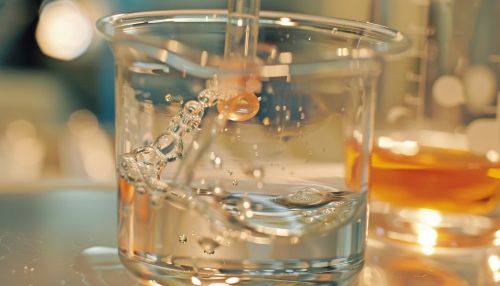Chemical change
Introduction
Chemical change, also known as a chemical reaction, is a process in which one or more substances, the reactants, are converted to one or more different substances, the products. Substances are either chemical elements or compounds. A chemical reaction rearranges the constituent atoms of the reactants to create different substances as products.


Characteristics of Chemical Change
Chemical changes are characterized by the formation of new substances and the making and breaking of strong chemical bonds. During a chemical change, the number and type of atoms remain constant, but their arrangement in space changes. This is a fundamental concept in chemistry known as the Law of Conservation of Mass.
Energy Change
Chemical changes often involve observable energy changes, usually in the form of heat, light, or sound. For example, the combustion of gasoline in an automobile engine produces heat, light, and sound. Energy changes in chemical reactions result from the making and breaking of chemical bonds.
Color Change
A change in color can be indicative of a chemical change. For example, when iron rusts, it changes from silver-gray to reddish-brown. This is due to a chemical change where the iron reacts with oxygen in the air to form iron(III) oxide.
Gas Production
The formation of a gas is another sign of a chemical change. For example, when baking soda and vinegar are combined, the chemical reaction produces a gas called carbon dioxide.
Formation of a Precipitate
A precipitate is a solid that forms out of a solution during a chemical change. An example of this is when two clear solutions are mixed together and a solid substance forms and falls to the bottom of the container.
Types of Chemical Changes
Chemical changes can be classified into different types based on the nature of the reaction.
Synthesis Reactions
In a synthesis reaction, two or more simple substances combine to form a more complex substance. The general form of a synthesis reaction is A + B → AB.
Decomposition Reactions
Decomposition reactions are the opposite of synthesis reactions. In a decomposition reaction, a complex substance breaks down into its more simple parts. The general form of a decomposition reaction is AB → A + B.
Single Displacement Reactions
In a single displacement reaction, one element trades places with another element in a compound. The general form of a single displacement reaction is A + BC → AC + B.
Double Displacement Reactions
In a double displacement reaction, the anions and cations of two different molecules switch places, forming two entirely different compounds. The general form of a double displacement reaction is AB + CD → AD + CB.
Combustion Reactions
A combustion reaction is a reaction that occurs when a substance reacts with oxygen, releasing energy in the form of light and heat. The general form of a combustion reaction is A + O2 → AO.
Factors Affecting Chemical Changes
Several factors can affect the rate at which chemical changes occur. These include the concentration of reactants, temperature, pressure, and the presence of catalysts.
Concentration of Reactants
The concentration of reactants can greatly affect the rate of a chemical change. As the concentration of reactants increases, the rate of reaction also increases. This is because there are more particles available to react, leading to more frequent collisions.
Temperature
Temperature is another factor that can influence the rate of a chemical change. As the temperature increases, the rate of reaction also increases. This is because the particles have more energy and collide more frequently and with greater force.
Pressure
In reactions involving gases, an increase in pressure leads to an increase in the rate of reaction. This is because the gas particles are forced closer together, leading to more frequent collisions.
Catalysts
Catalysts are substances that speed up the rate of a chemical reaction without being consumed in the reaction. They work by lowering the activation energy required for the reaction to occur.
Conclusion
Chemical changes play a crucial role in many aspects of life, from the metabolism of food in our bodies to the combustion of fuel in cars. Understanding these changes allows us to predict and control the outcomes of reactions, leading to advancements in fields such as medicine, materials science, and energy production.
